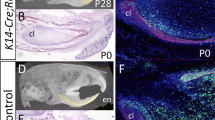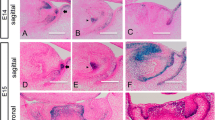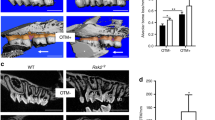Abstract
Objective:
RUNX2, in the Runt gene family, is one of the most important transcription factors in the development of the skeletal system. Research in recent decades has shown that this factor plays a major role in the development, growth and maturation of bone and cartilage. It is also important in tooth development, mechanotransduction and angiogenesis, and plays a significant role in various pathological processes, i.e. tumor metastasization. Mutations in the RUNX2 gene correlate with the cleidocranial dysplasia (CCD) syndrome, important to dentistry, particularly orthodontics because of its dental and orofacial symptoms. Current research on experimentally-induced mouse mutants enables us to study the etiology and pathogenesis of these malformations at the cellular and molecular biological level. This study’s aim is to provide an overview of the RUNX2 gene’s function especially in skeletal development, and to summarize our research efforts to date, which has focused on investigating the influence of RUNX2 on mandibular growth, which is slightly or not at all altered in many CCD patients.
Materials and Methods:
Immunohistochemical analyses were conducted to reveal RUNX2 in the condylar cartilage of normal mice and of heterozygous RUNX2 knockout mice in early and late growth phases; we also performed radiographic and cephalometric analyses.
Results:
We observed that RUNX2 is involved in normal condylar growth in the mouse and probably plays a significant role in osteogenesis and angiogenesis. The RUNX2 also has a biomechanical correlation in relation to cartilage compartmentalization. At the protein level, we noted no differences in the occurrence and distribution of RUNX2 in the condyle, except for a short phase during the 4th and 6th postnatal weeks, so that one allele might suffice for largely normal growth; other biological factors may have compensatory effects. However, we did observe small changes in a few cephalometric parameters concerning the mandibles of heterozygous knockout animals. We discuss potential correlations to our findings by relating them to the most current knowledge about the RUNX2 biology.
Zusammenfassung
Ziel:
Zu den wichtigsten Transkriptionsfaktoren für die Entwicklung des Skelettsystems gehört RUNX2 aus der Familie der Runt- Gene. Die Forschungen der letzten Jahrzehnte zeigten, dass dieser Faktor eine große Rolle in der Entwicklung, dem Wachstum und der Reifung von Knochen und Knorpel spielt. Darüber hinaus ist er für Zahnentwicklung, Mechanotransduktion und Angiogenese wichtig und hat eine Bedeutung bei verschiedenen pathologischen Prozessen wie z.B. der Tumormetastasierung. Mutationen im RUNX2-Gen sind mit dem Syndrom der Dysplasia cleidocranialis (CCD) korreliert, das aufgrund seiner dentalen und orofazialen Symptomatik für die Zahnmedizin und insbesondere die Kieferorthopädie von Wichtigkeit ist. Die Untersuchung experimentell induzierter Mausmutanten erlaubt heutzutage Forschungen zur Ätiologie und Pathogenese dieser Fehlbildungen auf zell- und molekularbiologischer Ebene. Die vorliegende Arbeit soll eine Übersicht über die Funktion des RUNX2-Gens vor allem in der Skelettentwicklung und eine Zusammenfassung bisheriger eigener Forschungsarbeiten geben. Dabei ging es vor allem um die Frage des Einflusses von RUNX2 auf das Wachstum der Mandibula, die bei vielen CCD-Patienten nicht oder nur gering verändert ist.
Material und Methodik:
Immunhistochemische Untersuchungen wurden zum Nachweis von RUNX2 am Kondylenknorpel normaler Mäuse sowie von heterozygoten RUNX2-Knockout- Mäusen in frühen und späten Wachstumsphasen durchgeführt sowie röntgenologisch-kephalometrische Untersuchungen.
Ergebnisse:
RUNX2 war am normalen Kondylenwachstum der Maus beteiligt und wahrscheinlich auch in der Osteo- und Angiogenese sowie im Zusammenhang mit einer möglicherweise biomechanisch korrelierten Kompartimentierung des Knorpels von Bedeutung. Auf Proteinebene konnten bis auf eine kurze Phase während der 4. bis 6. postnatalen Woche keine Unterschiede im Auftreten und in der Verteilung von RUNX2 im Kondylus festgestellt werden, so dass womöglich ein Allel für ein weitgehend regelrechtes Wachstum ausreicht bzw. Kompensationen durch andere biologische Faktoren vermutet werden können. Dennoch konnten für einige kephalometrische Parameter an den Mandibulae heterozygoter Knockout-Tiere Veränderungen im Sinne einer reduzierten Dimension festgestellt werden. Mögliche Zusammenhänge zwischen diesen Befunden werden auf den Grundlagen neuer Erkenntnisse zur Biologie von RUNX2 diskutiert.
Similar content being viewed by others
References
Aberg T, Cavender A, Gaikwad JS, et al. Phenotypic changes in dentition of Runx2 homozygote-null mutant mice. J Histochem Cytochem 2004; 52:131–9.
Aberg T, Wand XP, Kim JH, et al. Runx2 mediates FGF signaling from epithelium to mesenchyme during tooth morphogenesis. Dev Biol 2004; 270:76–93.
Bae SC, Lee YH. Phosphorylation, acetylation and ubiquitination: the molecular basis of RUNX regulation. Gene 2006; 366:58–66.
Baumert U, Golan I, Driemel O, et al. Dysotosis cleidocranialis — Beschreibung und Analyse einer Patientengruppe. Mund Kiefer Gesichtschir 2006;10:385–93.
Bronckers AL, Sasaguri K, Cavender AC, et al. Expression of Runx2/Cbfa1/Pebp2alphaA during angiogenesis in postnatal rodent and fetal human orofacial tissues. J Bone Miner Res 2005;20:428–37.
Camilleri S, McDonald F. Runx2 and dental development. Eur J Oral Sci 2006;114:361–73.
Chen J, Sorensen KP, Gupta T, et al. Altered functional loading causes differential effects in the subchondral bone and condylar cartilage in the temporomandibular joint from young mice. Osteoarthritis Cartilage 2009;17:354–61.
Chen S, Santos L, Wu Y, et al. Altered gene expression in human cleidocranial dysplasia dental pulp cells. Arch Oral Biol 2005;50:227–36.
Cooper SC, Flaitz CM, Jonston DA, et al. A natural history of cleidocranial dysplasia. Am J Med Genet 2001;104:1–6.
Counts AL, Rohrer MD, Prasad H, Bolen P. An assessment of root cementum in cleidocranial dysplasia. Angle Orthod 2001;71:293–8.
D’souza RN, et al. Cbfa1 is required for epithelial-mesenchymal interactions regulating tooth development in mice. Development 1999;126:2911–20.
Daskalogiannakis J, Piedade L, Lindhlm TC, et al. Cleidocranial dysplasia: 2 generations of management. J Can Dent Assoc 2006;72:337–42.
Delatte M, von den Hoff JW, van Rheden REM, Kuijpers-Jagtman AM. Primary and secondary cartilages of the neonatal rat: the femoral head and the mandibular condyle. Eur J Oral Sci 2004;112:156–62.
Deng ZL, Sharff KA, Tang N, et al. Regulation of osteogenic differentiation during skeletal development. Front Biosci 2008;13:2001–21.
Ducy P, Zhang R, Geoffroy V, et al. Osf2/Cbfa1: a transcriptional activator of osteoblast differentiation. Cell 1997;89:747–54.
Everett ET, et al. Craniometric and radiographic morphology. MPD:110. Mouse Phenome Database Web Site 2003, World Wide Web (http://www.jax.org/phenome, cited 31.05. 2009)
Franceschi RT, Xiao G. Regulation of the osteoblast-specific transcription factor, Runx2: responsiveness to multiple signal transduction pathways. J Cell Biochem 2003;88:446–54.
Gaikwad JS, Hoffmann M, Cavender A, et al. Molecular insights into the lineage-specific determination of odontoblasts: the role of Cbfa1. Adv Dent Res 2001;15:19–24.
Golan I, Baumert U, Hrala BP, Müßig D. Dentomaxillofacial variability of cleidocranial dysplasia: clinicoradiological presentation and systematic review. Dentomaxillofac Radiol 2003;32:347–54.
Golan I, Baumert U, Hrala BP, Müßig D. Early craniofacial signs of cleidocranial dysplasia. Int J Paediatr Dent 2004;14:49–53.
Golan I, Baumert U, Hrala BP, et al. Symptome und Merkmale bei Dysostosis cleidocranialis (DCC). Z Orthop Ihre Grenzgeb 2003;141:336–40.
Goldring MB, Tsuchimochi K, Ijiri K. The control of chondrogenesis. J Cell Biochem 2006;97:33–44.
Götz W, Dühr S, Jäger A. Distribution of components of the insulinlike growth factor system in the temporomandibular joint of the aging mouse. Growth Dev Aging 2005;69:67–79.
Götz W, Gerber T, Michel B, et al. Immunohistochemical characterization of nanocrystalline hydroxyapatite silica gel (NanoBone®) osteogenesis: a study on biopsies from human jaws. Clin Oral Implants Res 2008;19:1016–26.
Hirata A, Sugahara T, Nakamura H. Localization of runx2, osterix, and osteopontin in tooth root formation in rat molars. J Histochem Cytochem 2009;57:397–403.
Hirschfelder U, Mussig D, Fleischer-Peters A. Untersuchungen zur Schädelmorphologie bei Dysostosis Cleidocranialis. Dtsch Zahnarztl Z 1991;46:292–6.
Ichikawa Y, Sumi M, Ohwatari N, et al. Evaluation of 9.4-T MR micro-imaging in assessing normal and defective fetal bone development: comparison of MR imaging and histological findings. Bone 2004;34:619–28.
Inada M, Yasul T, Nomura S, et al. Maturational disturbance of chondrocytes in Cbfa1-deficient mice. Dev Dyn 1999;214:279–90.
Ishii K, Nielsen IL, Vargervik K. Characteristics of jaw growth in cleidocranial dysplasia. Cleft Palate Craniofac J 1998;35:161–6.
Ito Y. RUNX genes in development and cancer: regulation of viral gene expression and the discovery of RUNX family genes. Adv Cancer Res 2008;99:33–76.
James MJ, Jarvinen E, Wang XP, Thesleff I. Different roles of Runx2 during early neural crest-derived bone and tooth development. J Bone Miner Res 2006;21:1034–44.
Jensen BL. Cleidocranial dysplasia: craniofacial morphology in adult patients. J Craniofac Genet Dev Biol 1994;14:163–76.
Jensen BL, Kreiborg S. Development of the dentition in cleidocranial dysplasia. J Oral Pathol Med 1990;19:89–93.
Jensen BL, Kreiborg S. Craniofacial growth in cleidocranial dysplasia — a roentgencephalometric study. J Craniofac Genet Dev Biol 1995;15:35–43.
Jiang H, Sodek J, Karsenty G, et al. Expression of core binding factor Osf2/Cbfa-1 and bone sialoprotein in tooth development. Mech Dev 1999;81:169–73.
Kamekura S, Kawasaki Y, Hoshi K, et al. Contribution of runt-related transcription factor 2 to the pathogenesis of osteoarthritis in mice after induction of knee joint instability. Arthritis Rheum 2006;54:2462–70.
Kanno T, Takahashi T, Tsujisawa T, et al. Mechanical stress-mediated Runx2 activation is dependent on Ras/ERK1/2 MAPK signaling in osteoblasts. J Cell Biochem 2007;101:1266–77.
Karsenty G. Transcriptional control of skeletogenesis. Annu Rev Genomics Hum Genet 2008;9:183–96.
Kawarizadeh A, Bourauel C, Götz W, Jäger A. Early responses of periodontal ligament cells to mechanical stimulus in vivo. J Dent Res 2005;84:902–6.
Kerr HD. Cleidocranial dysplasia. J Rheumatol 1988;15:359–61.
Kim IS, Otto F, Zabel B, Mundlos S. Regulation of chondrocyte differentiation by Cbfa1. Mech Dev 1999;80:159–70.
Kobayashi I, Kiyoshima T, Wada H, et al. Type II/III Runx2/Cbfa1 is required for tooth germ development. Bone 2006;38:836–44.
Komori T. Runx2, a multifunctional transcription factor in skeletal development. J Cell Biochem 2002;87:1–8.
Komori T. Regulation of skeletal development by the Runx family of transcription factors. J Cell Biochem 2005;95:445–53.
Komori T. Regulation of bone development and maintenance by Runx2. Front Biosci 2008;13:898–903.
Kreiborg S, Jensen BL, Larsen P, et al. Anomalies of craniofacial skeleton and teeth in cleidocranial dysplasia. J Craniofac Genet Dev Biol 1999;19:75–9.
Kuboki T, Kanyama M, Nakanishi T, et al. Cbfa1/Runx2 gene expression in articular chondrocytes of the mice temporomandibular and knee joints in vivo. Arch Oral Biol 2003;48:519–25.
Kusafuka K, Sasaguri K, Sato S, et al. Runx2 expression is associated with pathologic new bone formation around radicular cysts: an immunohistochemical demonstration. J Oral Pathol Med 2006;35:492–9.
Lee HJ, Koh JM, Hwang JY, et al. Association of a RUNX2 promoter polymorphism with bone mineral density in postmenopausal Korean women. Calcif Tissue Int 2009;84:439–45.
Lefebvre V, Smits P. Transcriptional control of chondrocyte fate and differentiation. Birth Defects Res C Embryo Today 2005;75:200–12.
Li YL, Xiao ZS. Advances in Runx2 regulation and its isoforms. Med Hypotheses 2007;68:169–75.
Lou Y, Javed A, Hussain S, et al. A Runx2 threshold for the cleidocranial dysplasia phenotype. Hum Mol Genet 2009;18:556–68.
Luder HU. Age changes in the articular tissue of human mandibular condyles from adolescence to old age: a semiquantitative light microscopic study. Anat Rec 1998;251:439–47.
Lukinmaa P L, Jensen BL, Thesleff I, et al. Histological observations of teeth and peridental tissues in cleidocranial dysplasia imply increased activity of odontogenic epithelium and abnormal bone remodeling. J Craniofac Genet Dev Biol 1995;15:212–21.
Manis JP. Knock out, knock in, knock down — genetically manipulated mice and the Nobel Prize. N Engl J Med 2007;357:2426–9.
Marie PJ. Transcription factors controlling osteoblastogenesis. Arch Biochem Biophys 2008;473:98–105.
Maruyama Z, Yoshida CA, Furuichi T, et al. Runx2 determines bone maturity and turnover rate in postnatal bone development and is involved in bone loss in estrogen deficiency. Dev Dyn 2007;236:1876–90.
McAlarney ME, Rizos M, Rocca EG, et al. The quantitative and qualitative analysis of the craniofacial skeleton of mice lacking the IGF-I gene. Clin Orthod Res 2001;4:206–19.
McNamara CM, O’Riordan BC, Blake M, Sandy JR. Cleidocranial dysplasia: radiological appearances on dental panoramic radiography. Dentomaxillofac Radiol 1999;28:89–97.
Mundlos S. Cleidocranial dysplasia: clinical and molecular genetics. J Med Genet 1999;36:177–82.
Mundlos S, Otto F, Mundlos C, et al. Mutations involving the transcription factor CBFA1 cause cleidocranial dysplasia. Cell 1997;89:773–9.
Naitoh M, Kubota H, Ikeda M, et al. Gene expression in human keloids is altered from dermal to chondrocytic and osteogenic lineage. Genes Cells 2005;10:1081–91.
Otto F, Thornell AP, Crompton T, et al. Cbfa1, a candidate gene for cleidocranial dysplasia syndrome, is essential for osteoblast differentiation and bone development. Cell 1997;89:765–71.
Perinpanayagam H, Al-Rabeah E. Osteoblasts interact with MTA surfaces and express Runx2. Oral Surg Oral Med Oral Pathol Oral Radiol Endod 2009;107:590–6.
Perinpanayagam H. Alveolar bone osteoblast differentiation and Runx2/Cbfa1 expression. Arch Oral Biol 2006;51:406–15.
Pospieszynska MD. Morphological changes of the mandible and temporomandibular joints in a patient with cleidocranial dysostosis. J Orofac Orthop 1998;59:246–50.
Pratap J, Wixted JJ, Gaur T, et al. Runx2 transcriptional activation of Indian Hedgehog and a downstream bone metastatic pathway in breast cancer cells. Cancer Res 2008;68:7795–802.
Quack I, Vonderstrass B, Stock M, et al. Mutation analysis of core binding factor A1 in patients with cleidocranial dysplasia. Am J Hum Genet 1999;65:1268–78.
Rabie AB, Shum L, Chayanupatkul A. VEGF and bone formation in the glenoid fossa during forward mandibular positioning. Am J Orthod Dentofacial Orthop 2002;122:202–9.
Rabie AB, Tang GH, Hagg U. Cbfa1 couples chondrocytes maturation and endochondral ossification in rat mandibular condylar cartilage. Arch Oral Biol 2004;49:109–18.
Ramirez-Yanez GO, Smid JR, Young WG, Waters MJ. Influence of growth hormone on the craniofacial complex of transgenic mice. Eur J Orthod 2005;27:494–500.
Richardson A, Deussen FF. Facial and dental anomalies in cleidocranial dysplasia: a study of 17 cases. Int J Paediatr Dent 1994;4:225–31.
Ryoo HM, Wang XP. Control of tooth morphogenesis by Runx2. Crit Rev Eukaryot Gene Expr 2006;16:143–54.
Schroeder TM, Jensen ED, Westendorf JJ. Runx2: a master organizer of gene transcription in developing and maturing osteoblasts. Birth Defects Res C Embryo Today 2005;75:213–25.
Shen Q, Christakos S. The vitamin D receptor, Runx2, and the Notch signaling pathway cooperate in the transcriptional regulation of osteopontin. J Biol Chem 2005;280:40589–98.
Shibata S, Suda N, Suzuki S, et al. An in situ hybridization study of Runx2, Osterix, and Sox9 at the onset of condylar cartilage formation in fetal mouse mandible. J Anat 2006;208:169–77.
Shibata S, Yokohama-Tamaki T. An in situ hybridization study of Runx2, Osterix, and Sox9 in the anlagen of mouse mandibular condylar cartilage in the early stages of embryogenesis. J Anat 2008;213:274–83.
Shimizu T. Participation of Runx2 in mandibular condylar cartilage development. Eur J Med Res 2006;11:455–61.
Singh M, Detamore MS. Biomechanical properties of the mandibular condylar cartilage and their relevance to the TMJ disc. J Biomech 2009;42:405–17.
Singleton DA, Buschang PH, Behrents RG, Hinton RJ. Craniofacial growth in growth hormone-deficient rats after growth hormone supplementation. Am J Orthod Dentofacial Orthop 2006;130:69–82.
Suba Z, Balaton G, Gyulai-Gaal S, et al. Cleidocranial dysplasia: diagnostic criteria and combined treatment. J Craniofac Surg 2005;16:1122–6.
Sudhakar S, Katz MS, Elango N. Analysis of type-I and type-II RUNX2 protein expression in osteoblasts. Biochem Biophys Res Commun 2001;286:74–9.
Sudhakar S, Li Y, Katz MS, Elango N. Translational regulation is a control point in RUNX2/Cbfa1 gene expression. Biochem Biophys Res Commun 2001;289:616–22.
Sun L, Vitolo M, Passaniti A. Runt-related gene 2 in endothelial cells: inducible expression and specific regulation of cell migration and invasion. Cancer Res 2001;61:4994–5001.
Tang GH, Rabie AB. Runx2 regulates endochondral ossification in condyle during mandibular advancement. J Dent Res 2005;84:166–71.
Vandeberg JR, Buschang PH, Hinton RJ. Craniofacial growth in growth hormone-deficient rats. Anat Rec A Discov Mol Cell Evol Biol 2004;278:561–70.
Watanabe T, Nakano N, Muraoka R, et al. Role of Msx2 as a promoting factor for Runx2 at the periodontal tension sides elicited by mechanical stress. Eur J Med Res 2008;13:425–31.
Yoda S, Suda N, Kitahara Y, et al. Delayed tooth eruption and suppressed osteoclast number in the eruption pathway of heterozygous Runx2/Cbfa1 knockout mice. Arch Oral Biol 2004;49:435–42.
Zheng Q, Sebald E, Zhou G, et al. Dysregulation of chondrogenesis in human cleidocranial dysplasia. Am J Hum Genet 2005;77:305–12.
Zheng Q, Zhou G, Morello R, et al. Type X collagen gene regulation by Runx2 contributes directly to its hypertrophic chondrocyte-specific expression in vivo. J Cell Biol 2003;162:833–42.
Ziros PG, Basdra EK, Papavassiliou AG. Runx2: of bone and stretch. Int J Biochem Cell Biol 2008;40:1659–63.
Zou SJ, D’souza RN, Ahlberg T, et al. Tooth eruption and cementum formation in the Runx2/Cbfa1 heterozygous mouse. Arch Oral Biol 2003;48:673–7.
Author information
Authors and Affiliations
Corresponding author
Rights and permissions
About this article
Cite this article
Rath-Deschner, B., Daratsianos, N., Dühr, S. et al. The Significance of RUNX2 in Postnatal Development of the Mandibular Condyle. J Orofac Orthop 71, 17–31 (2010). https://doi.org/10.1007/s00056-010-9929-7
Received:
Accepted:
Published:
Issue Date:
DOI: https://doi.org/10.1007/s00056-010-9929-7




